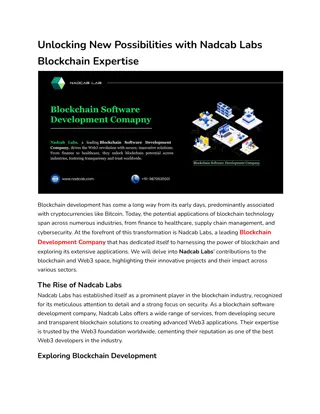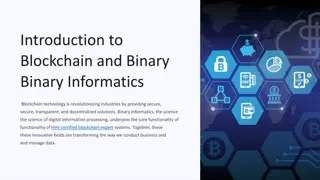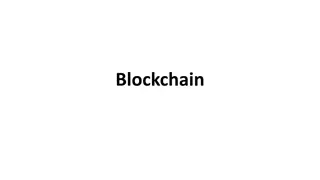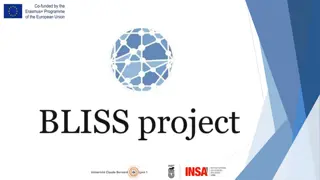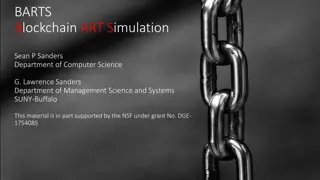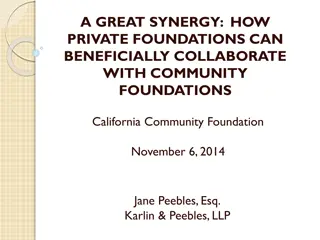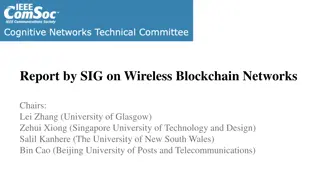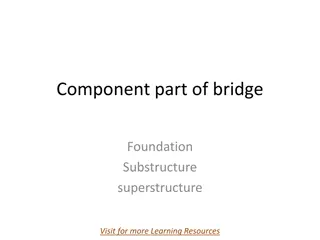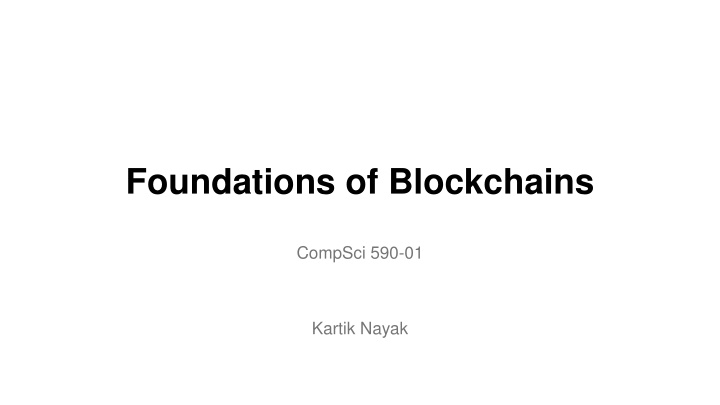
Foundations of Blockchain - Course Overview
This course covers permissioned and permissionless consensus, networking models, cryptography assumptions, classical protocols, sybil resistance mechanisms, layer 1 improvements, layer 2 solutions, and decentralized finance. Explore various blockchain designs such as Paxos, PBFT, Bitcoin, Ethereum, and more to deepen your understanding of this transformative technology.
Download Presentation

Please find below an Image/Link to download the presentation.
The content on the website is provided AS IS for your information and personal use only. It may not be sold, licensed, or shared on other websites without obtaining consent from the author. If you encounter any issues during the download, it is possible that the publisher has removed the file from their server.
You are allowed to download the files provided on this website for personal or commercial use, subject to the condition that they are used lawfully. All files are the property of their respective owners.
The content on the website is provided AS IS for your information and personal use only. It may not be sold, licensed, or shared on other websites without obtaining consent from the author.
E N D
Presentation Transcript
Foundations of Blockchains CompSci 590-01 Kartik Nayak
Instructor Kartik Nayak Research focus: Blockchains and privacy-preserving computation Email: kartik@cs.duke.edu Office hours: Monday 2-3 pm ET or by appointment Location: https://duke.zoom.us/j/98259428542 TA Sarisht Wadhwa Research focus: Blockchains and decentralized finance Email: sw485@cs.duke.edu
Course Details - - Course webpage: (to be created in a couple of days) Instruction mode: In-person - Zoom, only in exceptional cases Gradescope: For submitting assignments/projects Piazza: For discussions - Signup link: piazza.com/duke/fall2022/cs59001 - -
Topics Covered in this Course - Permissioned consensus - Different problem formulations - Different networking models and adversarial models - Different assumptions wrt cryptography and network timing - Classical protocols and impossibility results - Permissionless consensus - Nakamoto s longest chain consensus, committee based protocols - Mechanisms for sybil resistance: proof of work, proof of stake - Other aspects: difficulty adjustment, selfish mining, VRFs,
Topics Covered in this Course (2) - Approaches to improve layer 1 - Metrics: transaction throughput, latency, communication complexity, finality, energy consumption - Accountability: detecting and punishing misbehaving participants - Fairness and MEV - Tentative: Privacy mechanisms in ZCash Case studies for some layer 1 protocols: some subset of Paxos, PBFT, HotStuff (underlies Diem blockchain), Tendermint, Bitcoin, Ethereum, Internet Computer, Avalanche, Solana, and Algorand. -
Topics Covered in this Course (3) - Layer 2 solutions in Bitcoin and Ethereum - Payment channels, HTLC, lightning network, light clients - Optimistic and zk-rollups - Decentralized finance primitives and applications - Stablecoins, oracles, automated market makers Goal: Understand the similarities and differences that underlie blockchain designs such as Paxos, PBFT, Diem, Bitcoin, Ethereum, Internet Computer, Algorand, Solana, etc.
Grading Class participation: 15% Assignments: 30% Class presentation: 20% Project: 35% (subject to minor changes)
Class Participation Interactive class Read papers/reference reading materials before _every_ class Ask questions! Interrupt the instructor/presenter!
Assignments We will have two to four assignments in the semester We will use Gradescope to submit assignments ~1-2 weeks to submit them No additional time
Class Presentation Presenting research papers and leading discussions Goal: Learn to read and understand research papers and explain it your peers.
Project In groups of Broadly, any topic related to blockchains New protocol with better properties Implementation of an existing protocol in a practical setting Analyze and write a paper on a recent blockchain protocol Systemization of knowledge: Pick a sub-topic, read multiple papers in that area and write an SoK Engineering related projects are encouraged Goal: a paper worth publishing in a Computer Security/Distributed Computing workshop or a top-tier conference Do not procrastinate
General Guidelines All the submitted work should be your own Unless specified otherwise, for assignments you should not discuss with others or access the internet For projects, it is okay to discuss ideas within the group or with others
References Decentralized thoughts: a decentralized blog Bitcoin and cryptocurrency technologies Foundations of blockchains by Elaine Shi
What are the prerequisites? You are comfortable with proof-writing in an Algorithms course, e.g., CompSci 330 Will help if you have taken any distributed systems or computer security courses before In general, It is very easy to come up with an incorrect protocol It is also easy to come up with an incorrect proof
COVID Regulations Get tested before returning to campus Mask up in classes




